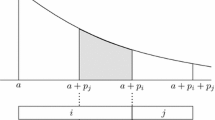Abstract
The advertisement placement problem deals with space and time sharing by advertisements on the Internet. Consider a Web page containing a rectangular display area (e.g., a banner) in which advertisements may appear. The display area can be utilized efficiently by allowing several small ads to appear simultaneously side by side, as well as by cycling through a schedule of ads, allowing different ads to be displayed at different times. A customer wishing to purchase advertising space specifies an ad size and a display count, which is the number of times their ad should appear during each cycle. The scheduler may accept or reject any given advertisement, but must be able to schedule all accepted ads within the given time and space constraints. Each advertisement has a non-negative profit associated with it, and the objective is to schedule a maximum-profit subset of ads. We present a (3 + ∈)-approximation algorithm for the general problem, as well as (2 + ∈)-approximation algorithms for two special cases.
Similar content being viewed by others
REFERENCES
Adler, M., P. B. Gibbons, and Y. Matias, "Scheduling space-sharing for Internet advertising," Journal of Scheduling, 5(2), 103–119 (2002).
Ausiello,G., P. Crescenzi, G. Gambosi, V.Kann, A. Marchetti-Spaccamela, and M. Protasi, Complexity andApproximation, Springer-Verlag, 1999.
Dawande, M., S. Kumar, and C. Sriskandarajah, "Performance bounds of algorithms for scheduling advertisements on a web page," Working paper 2001.
Graham, R. L., "Bounds for certain multiprocessing anomalies," Bell System Technical Journal, 45, 1563–1581 (1966).
Jansen, K., "On preemptive resource constrained scheduling: Polynomial time approximation schemes," in Proc. 9th Conference on Integer Programming and Combinatorial Optimization, vol. 2337 of Lecture Notes in Computer Science, Springer, 2002, pp. 329–349.
Kise, H., T. Ibaraki, and H. Mine, "A solvable case of one machine scheduling problem with ready and due dates," Operations Research, 26, 121–126 (1978).
Lawler, E. L., "Sequencing to minimize the weighted number of tardy jobs," Recherche Operationnel, 10, 27–33 (1976).
Lawler, E. L., "A dynamic programming algorithm for preemptive scheduling of a single machine to minimize the number of late jobs," Annals of Operations Research 26, 125–133 (1990).
Lawler, E. L., J. K. Lenstra, A. H. G. Rinnooy Kan, and D. B. Shmoys, "Sequencing and scheduling: Algorithms and complexity," in S. C. Graves, A. H. G. Rinnooy Kan and P. H. Zipkin, (eds.), Handbooks in Operations Research and Management Science, Volume 4: Logistics for Production and Inventory, North Holland, 1993, pp. 445–522.
Author information
Authors and Affiliations
Rights and permissions
About this article
Cite this article
Freund, A., Naor, J.(. Approximating the Advertisement Placement Problem. Journal of Scheduling 7, 365–374 (2004). https://doi.org/10.1023/B:JOSH.0000036860.90818.5f
Issue Date:
DOI: https://doi.org/10.1023/B:JOSH.0000036860.90818.5f




